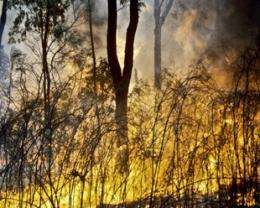Managing fire and biodiversity

A 23-year study of dry sclerophyll forests in south-eastern NSW has thrown new light on the role of fire in the landscape.
The study concluded that in its current form, hazard reduction burns will not have the same impact on understorey plant species in these forests as wildfire.
The study was originally established in 1985 by the then Forests NSW senior ecologist Bob Bridges and research forester Doug Binns and involved varying fire regimes applied to logged and unlogged sites in dry sclerophyll forests.
Data has recently been considered by Industry & Investment NSW scientists Dr Trent Penman, Dr Rod Kavanagh, Roy Shiels and Ruth Allen, and Forests NSW senior ecologist Doug Binns.
These forests typically consist of multi-aged stands of eucalypts with an understorey dominated by hard-leafed shrubs, grasses and ferns.
Trent said, over time, there had been a decline in the number of understorey plant species recorded and a shift in community structure that has occurred independently of the management regime.
“Overall, the above ground vegetation communities showed only minor responses to the prescribed fire and logging treatments.
“These changes are consistent with the expectations of the natural plant community dynamics with increasing time since wildfire,” he said.
Trent said dry sclerophyll forests have evolved with wildfire and have numerous strategies to cope with these disturbances. One of these is the storage of seeds within the soil to allow regeneration of the vegetation after a wildfire.
The study also examined the seed bank stored in the soil finding that logging increased the diversity and abundance of seedlings, while repeated prescribed burns had the opposite effect.
“The above ground vegetation communities showed only minor responses to management treatments, but these changes are more pronounced in the soil seed bank,” Trent said.
The results of the study suggest that where conservation of plant community diversity is the primary goal, management strategies are required that occasionally permit wildfire.
However, Trent said it was important to remember that this needs to be balanced with the need to protect valuable timber stands and, of course, life, property and assets on neighbouring properties.
Provided by New South Wales Government














